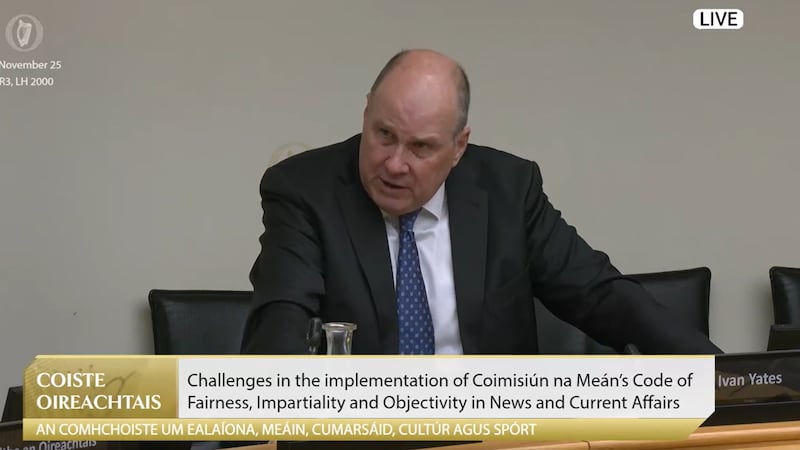An egregious omission from my recent History of Ireland in 100 Goodbyes was “The Harp that Once (Through Tara’s Halls).” Thomas Moore’s 1807 ballad bade farewell to a whole culture, that of Gaelic Ireland, as personified by a once-noble instrument, by then silenced.
But even allowing for poetic licence, Moore was slightly out of date in mourning the demise of the ancient harping tradition, thanks to a revival begun in Belfast 15 years earlier.
Organised by Edward Bunting and other members of the Society for Promoting Knowledge, the Belfast Harp Festival of 1792 was timed to coincide with the third anniversary of the French Revolution and enthusiastically supported by the United Irishmen, who were planning a revolution of their own.
It rounded up a dozen of the surviving old-style harpers, half of them blind, one aged 96. These were treated with great reverence as links to an ancient tradition, although not everyone in Belfast was enthralled.
Ronan McGreevy on the most damaging leak in Irish history
The strange case of Dr Achmet Borumborad and his Dublin-based Turkish baths
Firm friends: Finola Kennedy on a remarkable friendship between the founder of the Legion of Mary and former president WT Cosgrave
Ring of untruth – Frank McNally on how the Irish language gave ‘phoney’ to English
By the third day of the festival, a certain Theobald Wolfe Tone noted in his diaries: “The harpers again. Strum, strum, and be damned.”
Still, the event spawned a Belfast Harp School, to teach the venerable tradition to a new generation. And graduates of that, in time, including a great-great-granduncle of mine, Blind Patrick Byrne (circa 1799-1863).
Picking up where Moore’s elegy left off, Byrne was widely described in his lifetime as “the last of the great Irish harpers”.
When he died, a bit like the imagined one in Tara, his harp was retired and hung on a wall in the home of the local landlords, the Shirleys, who had long supported him.
That really might have been the end of the line for the old tradition. But no. As regular correspondent Owen Morton reminds me, the spirit of the Belfast Harp Festival of 1792 is itself now being revived in an annual event, co-hosted by Harp Ireland and a group called Reclaim the Enlightenment, and held both north and south of the Border.
Last year’s inaugural Harps Alive Festival marked the 230th anniversary of the original. This year’s instalment began in Belfast last month, but the Dublin (and Dundalk) part takes place this weekend.
Events include early-harp workshops at the Royal Irish Academy of Music, a talk and film about Bunting at the National Library, and a concert in the Pepper Cannister Church. More details at Harpireland.ie.
I note, by the way, that the festival’s trilingual titles include “Harps Leevin”. This is not to be confused with the “Leaving Cert”, which was included in my 100 goodbyes list. On the contrary, “leevin” is the Ulster-Scots word for “living”.
***
The uilleann pipes used to seem like a doomed instrument too. Then the folk revival happened and now they are among the most fashionable niche instruments on the planet, with more players than instrument makers can supply.
The very latest result of the renaissance is an interesting book and CD that landed in my inbox this week: New Songs from Old Stories by Sandie Purcell.
A former admin assistant for Na Píobairí Uilleann, Purcell is herself one of a small but growing number of female pipers. But she has several strings to her bow, literally and metaphorically, because she also plays the fiddle and is a composer.
Hence the book and album, in which – spurred on by NPU archivist Terry Moylan – she has taken a series of old poems or musically-orphaned ballads, provided them with new tunes, and recorded the results.
The collection includes “O Loydy George”, a lesser-known work by Peadar Kearney of Amhrán na bhFiann fame in which he satirises the then British prime minister David Lloyd George.
Also featured is a hitherto unknown (to me anyway) ballad eulogising a certain Dublin 8 suburb with which I am contrastingly familiar, although not as described in the lyrics.
Indeed, published anonymously in 1932, “I Shall Spend my Holidays at Inchicore” extols virtues of the neighbourhood that may until now have escaped even the most romantic of locals, eg:
“There the lovers love to spoon/Out beneath the silv’ry moon,/Though, in fancy, up above the stars they soar;/And each holds the other’s hand/As they listen to the band/Which plays upon the pier at Inchicore.”
After writing here earlier in the week about a history of neologisms (Diary, Thursday), Purcell’s collection has also taught me yet new word.
It comes up in an old Jimmy O’Dea-performed classic: a southside snob’s lament for modern Dublin’s descent into vulgarity, under the title: “Thank Heaven We are Living in Rathgar”.
The verse in question includes the lines: “Someone must live in Kilmainham/So it’s hardly fair to blame ‘em,/And in Dartry they are almost civilised/But in Fairview – Goodness gracious!/-fellows tennis in their braces/And in Drumcondra all their shirts are trubenized.”
I would have had to look it up, but Purcell beat me to it.
As her footnote explains, trubenization was a proprietary process once whereby shirt collars were rendered permanently stiff, precluding any need for starching, which for collars and upper lips alike was still de rigueur in Rathgar.
















